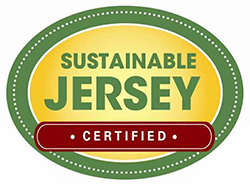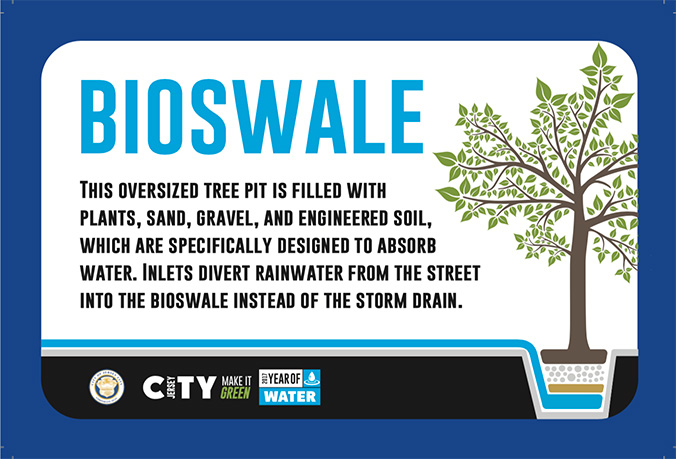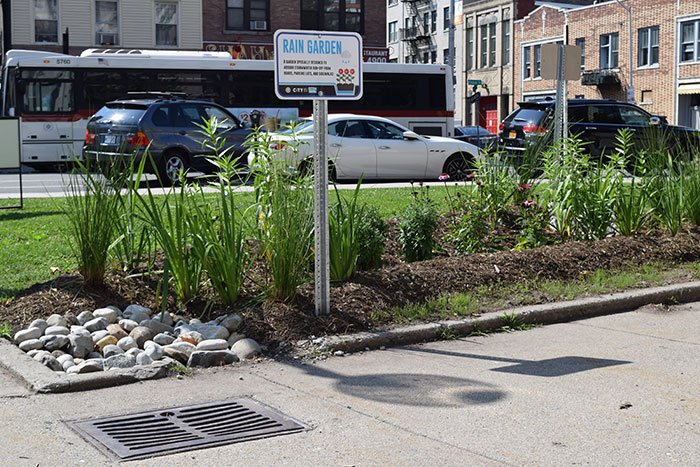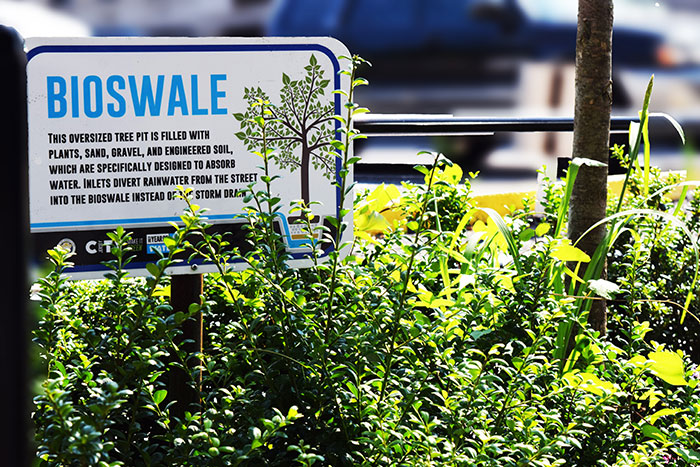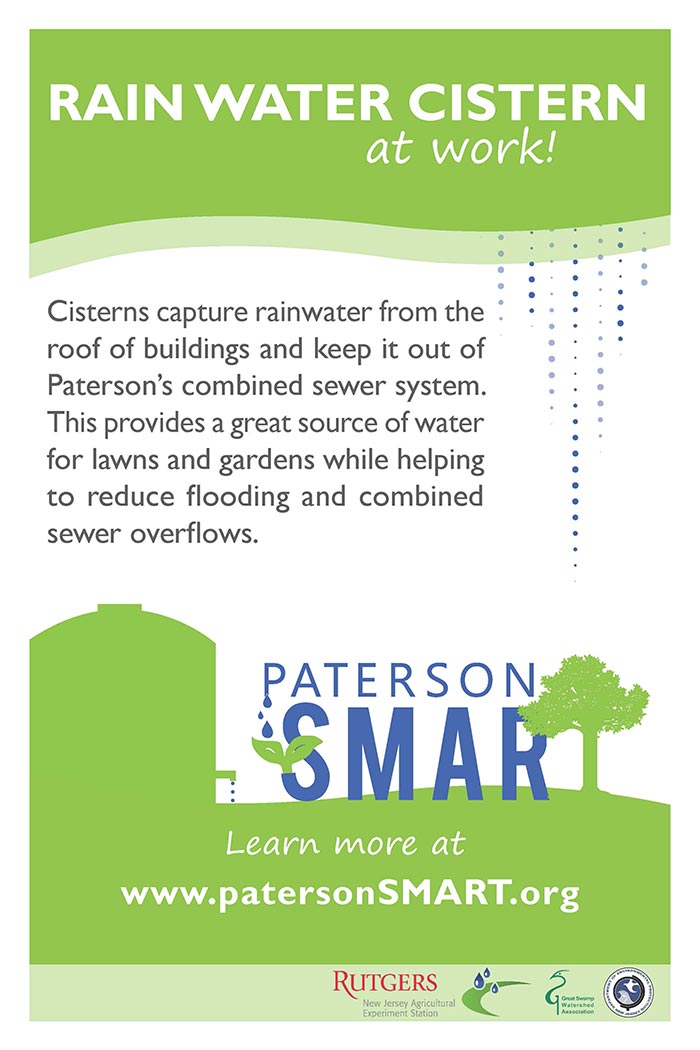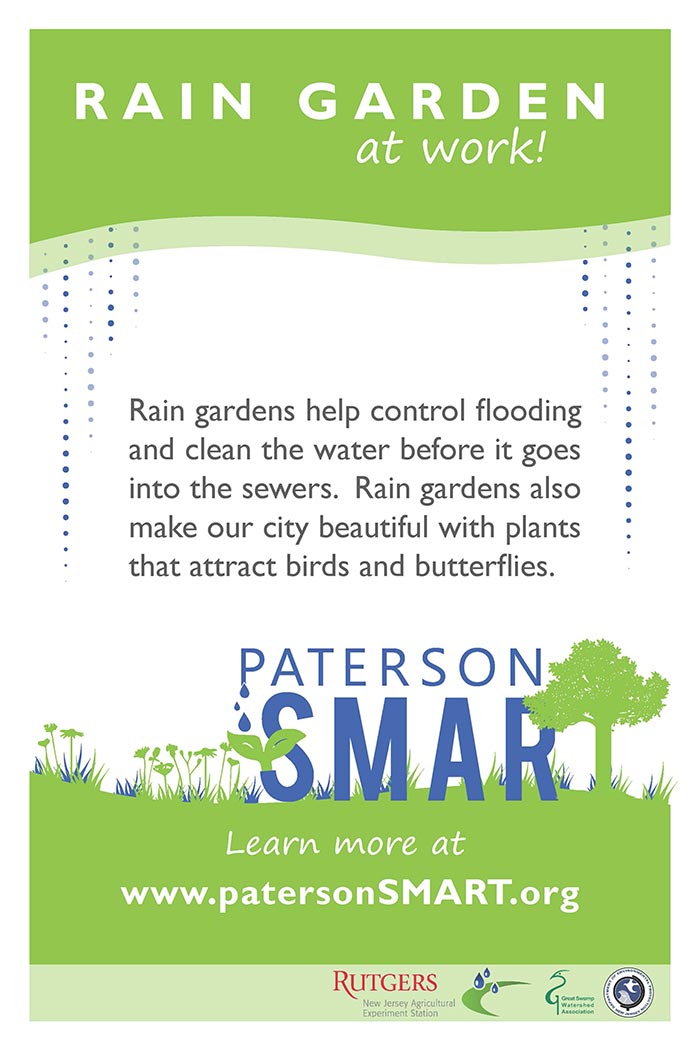Municipal Programs
Adopt-a-Catch-Basin Program
Adopt-a-Catch Basin programs beautify neighborhoods, reduce localized flooding, and help stop litter and debris from entering local waterways by encouraging residents to take care of a catch basin. Jersey City and Newark both have programs.
Compost Bin and Rain Barrel Sale
The Essex County Environmental Commission launched a bin and barrel garden sale to promote home composting, reduce waste, and capture rainwater to irrigate home gardens. The program offered The Earth Machine home compost bins at a discounted price of $50 (retail value $100) and 55-gallon rain barrels for $65.
Rain Barrel Giveaway Programs
Rain barrel giveaway programs are great opportunities to engage and educate residents about water conservation and stormwater management. Municipal staff can provide property owners with a rain barrel for free or at a reduced cost. Contact the Rutgers Cooperative Extension Water Resources Program to learn how to sponsor a rain barrel giveaway in your community.
Newark Rain Barrel Program
Jersey City Rain Barrel Program
Rain Garden Rebate Program
The Rutgers Cooperative Extension Water Resources Program partnered with the New Jersey Water Supply Authority Watershed Protection Program to offer rebates to homeowners who build rain gardens. Contact the Rutgers Cooperative Extension Water Resources Program to learn how to sponsor a rain garden rebate program in your town.
Year of Water
2017 was a ‘Year of Water’ for Jersey City. The initiative included a variety of events and programming designed to raise awareness around water infrastructure and conservation within the Jersey City community.
Resources for Your Residents
The Interactive Yard
The Interactive Yard is a tool designed to help you convert a yard from a lawn-dominated landscape into one that features beds with “Jersey-friendly” plants. As you transform the yard, you will remove high-maintenance lawn areas and reduce the need for fertilizers, add beds with native plants, reduce stormwater runoff and create habitat for wildlife and pollinators.
Green Infrastructure (GI) Wiz
GIWiz offers you access to a repository of EPA-sourced green infrastructure tools and resources designed to support and promote sustainable water management and community planning decisions. The tools and resources available through GIWiz will help you analyze problems, understand management options, calculate design parameters, analyze costs and benefits, evaluate tradeoffs, engage stakeholders, and/or develop education and outreach campaigns.
Rain Barrel Program
Take an active role in recycling rainwater – install a rain barrel at your house! Rain barrels collect about 50 gallons of water that can be used to water your lawn and plants. Harvesting rainwater has conserves water, prevents runoff pollution, saves money on water bills and can help prevent basement flooding.
Rain Barrel Train-the-Trainer Program
The goal of the Rain Barrel Train the Trainer program provides residents with tools to teach their communities how to build and install rain barrels. Program participants are provided with the Rainwater Harvesting with Rain Barrels Trainer Manual.
Rain Garden App
This smartphone app is designed to help users install a rain garden properly at home, office, or job site. Through video tutorials, diagrams, text, and tools, the app conveys how to determine the size and placement of a rain garden, evaluate soil type, measure the size of the drainage area, select plants, and install and maintain a rain garden.
Rain Garden Manual of New Jersey
This manual provides a step-by-step procedure to create a beautiful and sustainable rain garden landscape.
Stormwater Management in Your Backyard Program
The Rain Garden Outreach Manual equips volunteers such as master gardeners, environmental stewards, master naturalists and community environmental groups with the materials needed to deliver community-level outreach.
River-Friendly Programs
River-Friendly Certification Programs work one-on-one with residents, businesses, golf courses and schools to reduce pollution, conserve water, restore habitat for wildlife and educate the public about becoming better environmental stewards.
Green Infrastructure Overview
The eLearning tool provides an introduction to green infrastructure and highlights nine examples of green infrastructure practices. Through interactive activities, this tool explains how green infrastructure practices function.
Rainwater Harvesting with Rain Barrels Trainer Manual
Rain barrels are a great tool for promoting water conservation and the reduction of stormwater runoff in a community. This manual is designed to assist educators, municipalities, garden clubs, Cooperative Extension Master Gardeners, and environmental organizations in teaching others about the environmental benefits of rain barrels.
Stormwater Management in Your Backyard
Rutgers Cooperative Extension’s Stormwater Management in Your Backyard program empowers volunteers to educate their communities about the benefits of rain gardens. The program includes a Rain Garden Outreach Manual to provide volunteers, such as Master Gardeners, Environmental Stewards, Master Naturalists, municipal environmental commissions and community environmental groups with the materials needed to provide community-level outreach.
Resources for Your Schools
Next Generation Science Standards (NGSS)
Within the Next Generation Science Standards (NGSS), there are three distinct and equally important dimensions to learning science. The three dimensions include crosscutting concepts, science and engineering practices, and disciplinary core ideas. Science and Engineering Practices describe what scientists do to investigate the natural world and what engineers do to design and build systems. Students engage in practices to build, deepen, and apply their knowledge of core ideas and crosscutting concepts.
Stormwater Camp
The Wallkill River Watershed Management Group organized a week-long stormwater day camp for 2nd- to 7th-grade students at the McKeown Elementary School in Hampton. Through hands-on activities, games and demonstrations, the students learned how to prevent “people pollution” from entering local rivers and streams, how to conserve water by constructing rain barrels, how to design a rain garden to capture rooftop rainwater, and how to install native plants in one’s yard to collect stormwater runoff, allowing the water to soak into the ground instead of flowing over the land and collecting pollutants before entering the storm drains.
Project WET (Water Education for Teachers) Foundation
The award-winning, Project WET Curriculum and Activity Guide 2.0 gives educators of children from Pre-K and kindergarten to 12th grade the tools they need to integrate water education into every school subject.
Rain to Drain – Slow the Flow
Through a “Do, Reflect, and Apply” approach, Rain to Drain—Slow the Flow curriculum enables students to master the science of how water moves and help to design a community where water moves into the ground, becoming a helpful resource instead of a source of pollution and flooding.
Understanding the Urban Watershed
The Fairmount Water Works’ Understanding the Urban Watershed curriculum provides engaging lessons and activities, materials, rubrics and resources designed for the middle-school student to explore stormwater management. With a quick log-in option, it also offers formal and informal educators access to join an online discussion forum for sharing ideas, successes, and challenges.
Stormwater Management in Your Schoolyard
This program provides educational lectures, hands-on activities, and community-level outreach for students on the topics of water quality issues and stormwater management practices such as rain gardens and rain barrels. The program aims to provide students with an opportunity to apply their science, math, and communication skills to real-world environmental problems.
Urban Stormwater Management
Through the two lessons in this unit, students are introduced to green infrastructure and low-impact development technologies and take on the role of stormwater engineers through five associated activities. The unit prepares the students and teachers to design and install green infrastructure projects to manage stormwater at their school campuses, homes and communities.
The Watershed Institute Teacher Programs
The Watershed offers educator workshops and resources throughout the year at the Watershed Reserve. These workshops empower teachers, scout leaders, and home-school parents by increasing their understanding of the local natural environment through hands-on, inquiry-based activities that instill a sense of stewardship. Workshop facilitators are Watershed staff, state-certified to provide professional development.
National Environmental Education Foundation – Be Water Wise
Be Water Wise engages students in water-related activities such as math, science, geography and language skills. Students also create projects at their schools to help conserve water and reduce stormwater runoff, and present their projects to city officials.
EnviroScape®
The EnviroScape® series of portable models demonstrates water pollution concepts and prevention solutions. The models and kits can be integrated easily into any STEM education program — they are engaging and effective, as they create a real sense of understanding through experience and hands-on demonstration. Environmental education models make complex issues seem simple, helping people prevent water pollution in their communities.
Sewer in the Suitcase
The Sewer in a Suitcase is a model of a city sewer and water treatment system that was created to explore these and other questions about combined sewer systems The model and guide will help you lead your students through the ins and outs of the real system, using the pieces contained in the Sewer in the Suitcase. All you need to do is add water!
